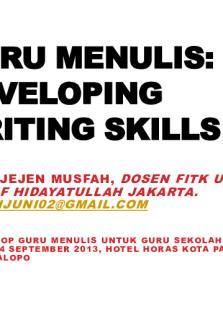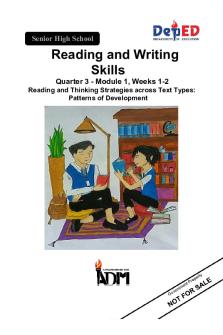Writing Skills - AAAAAAAAAAAAAAAAAAAAAAA PDF

| Title | Writing Skills - AAAAAAAAAAAAAAAAAAAAAAA |
|---|---|
| Course | Psychology 1A |
| Institution | University of New South Wales |
| Pages | 9 |
| File Size | 403.5 KB |
| File Type | |
| Total Downloads | 62 |
| Total Views | 148 |
Summary
AAAAAAAAAAAAAAAAAAAAAAA...
Description
Researching a topic
Searching - Google Scholar - Library website/ library search
Breaking down assessment question - Look for instruction words, key concepts and limiting words - Use broader or narrow words to get results - Selecting the right keywords can be vital for finding appropriate and useful journal articles. When performing literature searches, remember to try different combinations of keywords to see what you can find. - Use terms such as OR / AND to widen or narrow research o OR Widens / AND narrows Why perform literature searches? An important skill in research is being able to find and choose appropriate sources to support your arguments. You should always try to use peer-reviewed journal articles in scientific writing. Media reports/wikipedia/blogs are not appropriate sources for scientific writing What are peer-reviewed journal articles? Peer-reviewed journals (also known as refereed or scholarly journals) are journals that have a policy of only publishing articles that are reviewed by other experts in that domain before being published. This process helps protect against bad science and helps maintain the quality of research in the field. How do you know if a journal article was peer reviewed?
By limiting database searches to peer-reviewed journals only (when possible) Checking the journals website to see whether they say they are a peer-reviewed journal Checking databases like Ulrichsweb.com to see if the journal is listed as being "Refereed" Journal Article Databases The UNSW Library website also provides access to several journal article databases that can be used to locate journal articles. These include: Google Scholar psycINFO PubMed Scopus Using Google Scholar and psycINFO will be demonstrated on the following slides. PubMed and Scopus can be accessed and used in the same way.
Performing a literature search using psycINFO Try to perform a literature search now by opening the UNSW Library page in a separate tab and following the instructions on the following slides:
1. Go to the UNSW library homepage 2. Select the database tab 3. Type psycINFO in to the keyword search box 4. Select psycINFO from the list of databases 5. Click open source in a new window 6. Once you have entered your search the results will appear at the top of the page 7. Click on Display results
Accessing the Full text via UNSW Library Typically, scientific journals have paywalls that prevent you from accessing the full-text of articles.
As a UNSW student you have free access to journal articles if you access them using the UNSW Library website (https://www.library.unsw.edu.au). To access and download the full-text you need to search for the desired article in the UNSW Library search bar. If off campus: You will be prompted to enter your zID and zPass before you can access the article. You should then be able to view and download the full text of the article for free. What is a scientific argument? An argument is a logical process of reasoning. When writing assignments, arguments should be: Based on evidence For or against a point/theory/finding Convincing or persuading the reader Answering a question with evidence To form an argument you should: Research the empirical (experimental) findings on the area Summarise the experimental and theoretical findings Use the previous evidence as the base of your experimental rationale (argument) Provide a critique of the previous research Identify gaps in the literature: Are there any areas missing the research that should be investigated
Paraphrasing
To make effective arguments and avoid plagiarism you need to paraphrase previous research. Paraphrasing is when you explain the key points and ideas made by someone else but using your own words. Paraphrasing allows you to discuss the research, evidence and ideas raised by someone else legitmately to support your arguments. Paraphrasing is more effective than quoting because it is written in your own words, meaning that you demonstrate how well you understand the full meaning of the original work. A common mistake students make when attempting to paraphrase is rewriting the original sentence but only changing a few words. This is inappropriate paraphrasing, which is a form of plagiarism. It is very important to use your own words when paraphrasing other people's work and ideas. Some tips for effective paraphrasing 1.Read the original article until you understand its full meaning 2.Write notes about the article on a new page 3. Put the original document away 4. Write the paraphrased information on a new page 5. Double check your writing against the original
After paraphrasing, think to yourself: Have you expressed the information correctly? Is it written in your own words/language? Is it clear to the reader that you understand it? Are the two very similar?
Steps for paraphrasing: - Rewrite the sentence structure and modify words/phrases in it. - Use your own words while keeping its style - ALWAYS put author’s citation either at start or the end of the sentence Avoid direct quotes Whilst direct quotes can be useful in some circumstances, in general we would discourage you from using them in psychology assignments. Instead, we would encourage you to paraphrase the ideas and evidence you discuss in your own words. Unlike direct quotes, paraphrasing shows the reader that you understand the ideas being expressed and makes for a more effective argument. For example, instead of: This study found that "self-selected profile images conferred less favorable impressions when compared to other-selected images" (White, Sutherland, & Burton, 2017, p. 7). Try: This study found that the images selected by the person in the image were less flattering and less effective for making a positive first impression than the images other people selected of that person (White, Sutherland, & Burton, 2017). Another common mistake when paraphrasing is not referencing the original source. The original source can be different from where you first read the article. However, you should always cite the original article where the research was communicated rather than where you read it. For example, rather than: Experiments by Milgram tested whether people would be obedient following the orders of an authority figure when those orders appeared to cause harm and distress to another person (Dolinski et al., 2017).
Try: In his now infamous paradigm, Milgram investigated whether people would follow the orders given by an authority figure when it was clear those orders resulted in harm and distress in the other person (Milgram, 1963, 1965, 1974).
You must include an in-text citation AND reference list citation for every source you paraphrase in your work. Reference list should only include references cited in-text. In-text Citations (paraphrasing)
(Author Surname, Author Surname, & Author Surname, Year) e.g. (Whiston, Tai, Rahardja, & Eder, 2011)
In-text Citations (direct quotes)
You must include page numbers in the in-text citation if directly quoting a source. If quote is only from one page: (Whiston, Tai, Rahardja, & Eder, 2011, p. 37) If quote is from more than one page: (Whiston, Tai, Rahardja, & Eder, 2011, pp. 39-41)
Reference list
Title of section is: References Author Surname, First Initial. Second Initial., Author Surname, First Initial. Second Initial., & Author Surname, First Initial. Second Initial. (Year). Article title: Subtitle. Journal Title, Volume(issue), page range. doi:xx.xxxxxxxxxx Whiston, S. C., Tai, W. L., Rahardja, D., & Eder, K. (2011). School counseling outcome: A meta-analytic examination of interventions. Journal of Counseling & Development, 89(1), 3755. https://doi.org/10.1002/j.1556-6678.2011.tb00059.x
Reference management tools can organise your papers and format your citations for you (in any format not just APA). Popular reference management programs include:
Mendeley (freeware) Endnote (free to UNSW students)
Tips for writing an effective argument Write in a clear and concise manner
Using too many words can lead to your argument getting lost Don’t use large words if they aren’t needed…Keep it simple
Start with ordered dot points
You should be able to understand the entire argument in this format These dot points should tell a story Then fill in the specific evidence
Tell the reader a story
It is your job to produce a strong argument It is your job to provide the evidence It is your job to explain the evidence
Make it easy for the reader
The harder it is to read, the lower your mark Write clearly and explain your points
Don’t include too many points
Always better off explaining a few points in detail Don’t list information, EXPLAIN it
Paragraph structure Generally, paragraphs consist of 3 key components:
Topic Sentence
Body
One fact/statement that identifies for your reader the point
Explain the evidence State and introduce evidence
Conclusion
Should explain how evidence and topic sentence supports claim....
Similar Free PDFs

Writing Skills
- 29 Pages

Business Report Writing Skills
- 78 Pages

English Writing Skills
- 192 Pages

49860749-Byrne-Teaching-Writing-Skills
- 160 Pages

Writing Skills,emails,letters,memo
- 38 Pages

Resume for Report Writing Skills
- 3 Pages
Popular Institutions
- Tinajero National High School - Annex
- Politeknik Caltex Riau
- Yokohama City University
- SGT University
- University of Al-Qadisiyah
- Divine Word College of Vigan
- Techniek College Rotterdam
- Universidade de Santiago
- Universiti Teknologi MARA Cawangan Johor Kampus Pasir Gudang
- Poltekkes Kemenkes Yogyakarta
- Baguio City National High School
- Colegio san marcos
- preparatoria uno
- Centro de Bachillerato Tecnológico Industrial y de Servicios No. 107
- Dalian Maritime University
- Quang Trung Secondary School
- Colegio Tecnológico en Informática
- Corporación Regional de Educación Superior
- Grupo CEDVA
- Dar Al Uloom University
- Centro de Estudios Preuniversitarios de la Universidad Nacional de Ingeniería
- 上智大学
- Aakash International School, Nuna Majara
- San Felipe Neri Catholic School
- Kang Chiao International School - New Taipei City
- Misamis Occidental National High School
- Institución Educativa Escuela Normal Juan Ladrilleros
- Kolehiyo ng Pantukan
- Batanes State College
- Instituto Continental
- Sekolah Menengah Kejuruan Kesehatan Kaltara (Tarakan)
- Colegio de La Inmaculada Concepcion - Cebu









